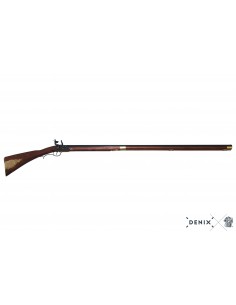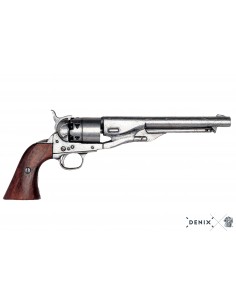American Civil War
€151.14
Carbines were more accurate than pistols and gave a longer effective range. However, the sequence of loading and firing was complex, so during training soldiers were required to repeat these movements until they could be performed instinctively amid the stress of combat. A well-trained soldier could fire up to five times a minute, but in combat a rate of...
€175.78
The Kentucky carbine was originally developed in Pennsylvania in the early 1700s and was widely used during the Revolutionary War (1775-1783), as settlers were familiar with it from hunting. These carbines accompanied early American explorers to the West and are often associated with Daniel Boone and Davy Crockett. When the American Civil War (1861-1865)...
€164.58
The Sharps carbine, created from the design of Christian Sharps in 1848, was a lifting bolt carbine which, in addition to being able to use a standard primer, had a rather unusual priming mechanism. This contained a column of percussion caps and placed one on the fireplace every time the trigger was pulled and the hammer fell, making it easier to fire.
€192.66
Its operation consists of a horizontal movement closure that has the needle in line inside; the lower lever, when actuated, unlocks the breech, then moves it backwards, uncovering the chamber, giving space to a lifting tile and mounts the firing pin from behind. At the end of its rearward travel, the breech causes a bullet to travel from the magazine to...
€235.84
The Model 1873 was a lever-action repeating rifle, that is, it allowed several shots to be fired before reloading, dislodging the used casing and replacing it with a new one by actuating a lever attached to the trigger guard; hence the term "repeating rifle". Its operation consists of a horizontal movement closure that has the needle in line inside; the...
€229.26
The Model 1873 was a lever-action repeating rifle, that is, it allowed several shots to be fired before reloading, dislodging the used casing and replacing it with a new one by actuating a lever attached to the trigger guard; hence the term "repeating rifle". Its operation consists of a horizontal movement closure that has the needle in line inside; the...
€225.04
The Model 1866, was nicknamed "Yellow Boy" because of its "brass" receiver (it was actually made of a type of bronze called gunmetal); it was a lever-action repeating carbine, that is, it allowed several shots to be fired before reloading, dislodging the used casing and replacing it with a new one by actuating a lever attached to the trigger guard; hence...
€212.20
Its operation consists of a horizontal movement closure that has the needle in line inside; the lower lever, when actuated, unlocks the breech, then moves it backwards, uncovering the chamber, giving space to a lifting tile and mounts the firing pin from behind. At the end of its rearward travel, the breech causes a bullet to travel from the magazine to...
€231.16
The Model 1866, was nicknamed "Yellow Boy" because of its "brass" receiver (it was actually made of a type of bronze called gunmetal); it was a lever-action repeating carbine, that is, it allowed several shots to be fired before reloading, dislodging the used casing and replacing it with a new one by actuating a lever attached to the trigger guard; hence...
€191.76
The Sharps rifle, created from the design of Christian Sharps in 1848, was a bolt action rifle that, in addition to being able to use a standard percussion cap, had a rather unusual priming mechanism. This contained a column of percussion caps and placed one on the chimney each time the trigger was pulled and the hammer fell, making it easier to fire. The...
€48.98
The Deringer Philadelphia was a muzzle-loading pocket pistol designed by Henry Deringer and produced from 1852 to 1868. These weapons fired a single shot, had a percussion ignition system, for use at very short distances, and were usually sold in pairs. ; The choice to buy a pair was due to the need to compensate for the limited power of a short barreled...
€51.03
Lincoln and Mary Todd went out to attend a performance at Ford's Theatre. The play was Our American Cousin, a musical comedy. As Lincoln sat in the box, John Wilkes Booth, a Virginia-based actor from Maryland and a sympathizer of the South, fired a single shot from a round-shot derringer pistol into the president's head and shouted "Sic semper tyrannis!"...
€78.48
The Kentucky pistol was an American weapon for early western explorers, used in the American War of Independence between 1775-1783 and the Civil War (1861-1865). Often matched with a rifle of the same caliber allowing the same lead ball to be fired.
€48.98
Deringer Philadelphia muzzle-loading pocket pistol designed by Henry Deringer and produced from 1852 to 1868. These weapons made a single shot, had a percussion ignition system, for use at very short distances and were almost always sold in pairs; The choice to buy a pair was due to the need to compensate for the limited power of a short-barreled...
€104.33
The film industry mythologized the "Peacemaker" in the westerns of the 40s and 50s, and was associated with great screen stars such as John Wayne or Gary Cooper. Also Roosevelt had one with his initials engraved and George S. Patton used two.















































